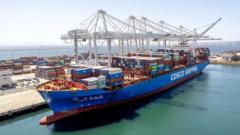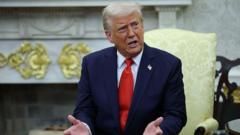The global shift towards renewable energy may face significant obstacles due to China's recent export ban on rare earth minerals, crucial for technologies like electric vehicles and wind turbines. This move comes in response to heightened tariffs imposed by the U.S. and underscores the complex interdependence in the supply chains of critical materials.
Global Energy Transition Faces Challenges Amid China's Rare Earth Export Ban

Global Energy Transition Faces Challenges Amid China's Rare Earth Export Ban
China's recent imposition of export controls on rare earth minerals exposes dependencies that could hinder global efforts for a sustainable energy future.
In 1886, a French chemist was immersed in the arduous process of isolating a new element from holmium oxide and ammonia. This element, dysprosium, named for its elusive nature, has now become indispensable in the construction of powerful magnets essential to wind turbines and electric vehicles. Recently, the relevance of dysprosium and other rare earth elements surged to the foreground when China declared an export ban that threatens to disrupt the supply of seven crucial minerals.
This decision is part of China's broader strategy to retaliate against the stringent tariffs imposed by President Trump, highlighting the intricate links between global trade and the renewable energy sector. As nations strive to combat climate change, these developments raise questions about the reliability of supply chains critical to the energy transition.
A report indicates that China is a dominant player in mining and refining more than half of the 50 minerals categorized by the U.S. as vital for national security and economic stability. Among these are lithium, cobalt, and nickel—essential components of the rechargeable batteries powering electric vehicles and storing renewable energy. The extent of China’s investment in mineral-rich regions, like nickel in Indonesia and cobalt in the Democratic Republic of Congo, further complicates the reliance on these materials.
While the rush for clean energy continues, the spotlight on rare earth elements amid geopolitical tensions signifies the potential hurdles that could arise for nations heavily reliant on these imports. As stakeholders assess the situation, the landscape of the global energy transition could be reshaped by emerging challenges catalyzed by political maneuvers and resource dependencies.
This decision is part of China's broader strategy to retaliate against the stringent tariffs imposed by President Trump, highlighting the intricate links between global trade and the renewable energy sector. As nations strive to combat climate change, these developments raise questions about the reliability of supply chains critical to the energy transition.
A report indicates that China is a dominant player in mining and refining more than half of the 50 minerals categorized by the U.S. as vital for national security and economic stability. Among these are lithium, cobalt, and nickel—essential components of the rechargeable batteries powering electric vehicles and storing renewable energy. The extent of China’s investment in mineral-rich regions, like nickel in Indonesia and cobalt in the Democratic Republic of Congo, further complicates the reliance on these materials.
While the rush for clean energy continues, the spotlight on rare earth elements amid geopolitical tensions signifies the potential hurdles that could arise for nations heavily reliant on these imports. As stakeholders assess the situation, the landscape of the global energy transition could be reshaped by emerging challenges catalyzed by political maneuvers and resource dependencies.






















